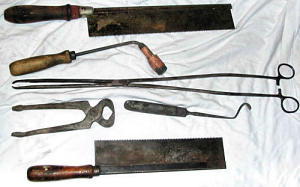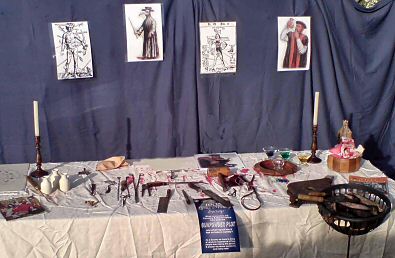Surgery
Barber, Doctor, Surgeon and Peruke (wig) maker in the 17th Century
Q: Whom would you see if you felt ill, or for everyday cuts and wounds if you could not afford to pay the hugely expensive charges of a real surgeon?
A: Your local Barber, or as some might call them today; 'Hairdresser'!
He would deal with all kinds of problems:
Checking your water (urine)
He would smell a sample, then taste it. He would also check the colour against an ancient chart, which even included such colours as blue, green, and red to see what was wrong with you. But remember; he needed a good fresh, hot sample, so that he could work out what was wrong with you.-

Blood letting
This was the most common cure for many problems. He would consult an astrological chart (see right) to see where your birth sign indicated your blood should flow from, then he would make small cuts or use leeches. Some birth sign cutting places were much more painful and delicate... so I wonder if people lied about their sign? Tooth extraction
Did you know that at the time it was thought little worms caused tooth ache? 'Oil of cloves' was used to kill the worms which caused the pain, and if that did not work he had a nice large pair of pliers to pull your tooth out!General injuries
Anything from simple cuts to amputations. Most barbers would have spent time on the battlefield, where they would have learnt (possibly the hard way for those he treated) and gained experience on a huge range of cuts and wounds. But do not worry; if the flesh did not get better and turned bad he could always use his maggots to clean the wound.
Yes your local Barber was a man of many trades, including wig maker; well he had all the requirements on the floor of his shop after cutting everyones hair!

17th century surgical tools. Would you want your doctor to use these?
There was no National Health Service in the 17th Century like we have today, so getting medical treatment was both costly and difficult. The average life expectancy was just thirty-eight years, and there was a high mortality rate for children. At this time towns were becoming more and more populated, and people knew little about health and hygiene. People did not wash very often, waste was disposed of on the streets, and clothes were beaten rather than washed. This meant that rats and flies were commonplace on the streets, allowing disease to spread easily and quickly.
Most people, especially in rural areas, consulted a midwife, who would have some knowledge of medical care and remedies. Women could not practice medicine at this time, so most learnt their trade from their mothers. However, midwives were associated with witchcraft, which hindered their status as a recognised medical practitioner.
Surgeons were also beginning to take an interest in childbirth, which provided a regular source of income. They began to invent technical devices to speed up delivery and improve the safety of mother and child. It was Peter Chamberlen who invented obstetric forceps. Dutch doctors also became experts at Caesarean Section. All this meant that doctors became more popular than midwives, who by the end of the 17th century were reduced to practicing among the poorer classes and post-natal nursing care.
Types of Doctor:
If you were wealthy enough, there were three types of doctor that you could visit if you were ill:
- An Apothecary sold and prepared medicines, much as a chemist does today. In 1600 it was estimated that there were only about one hundred of them in England, and their numbers only slightly increased throughout that century.
- Physicians thought they were the elite of the medical profession, and most had their practices in the larger towns and cities. However, they did not make much use of the advance in medical knowledge. The most notable physician of the 17th century was Thomas Sydenham, 1624- 1689. He carefully observed patients' symptoms to accurately diagnose them, and was aware of the properties of drugs. He gave iron for anaemia, quinine for malaria, and used opium for the relief of pain and to give his patients rest.
- Surgeons dealt with all the cases that required some kind of surgical operation. They were generally regarded as inferior to physicians because the first surgeons were barbers.
They had to complete seven years training; most of which was practical rather than academic. They acted under the instruction of the physician, and were generally unaware of the medical advances being made.
Performing Surgery in the 17th century:

Surgery was particularly gruesome. Without the knowledge and modern technology we have today, surgery was dangerous and survival rates low.
Hygiene was poor, with the surgeon operating in his everyday clothes, and surgical instruments were often left lying on the floor. As an anaesthetic, patients would either sniff opium-soaked sponges or drink large quantities of alcohol, but the patient still suffered and several men had to hold the patient down. It was common for the patient to die from loss of blood or infection from the filthy conditions.
Medicine was very different from today. There was no knowledge of germs or bacteria, no anti-biotics, penicillin or antiseptics to kill germs, and no pain killers to dull pain or knock a patient out during an operation.
People did not wash, and after an operation tools would probably only get wiped with a cloth; they wouldn't put tools in water, as that would make iron and steel rust. So rather that wash them, the surgeon would simply move on to his next patient.
Very little was known about the human body as most studies had been done on animals. It was only in 1565 that Queen Elizabeth I granted The Royal College of Surgeons the right to practice regular dissection, which means permission to cut up dead bodies for research. There was certainly no National Health Service as we have now.
What was believed to cause diseases in the 17th century?
Doctors believed in a theory that had been invented by the Ancient Greeks more than 1000 years earlier, known as 'The Four Humours'. This theory states that the whole world is made up of four elements; Air, Fire, Earth and Water. In the body these elements are supposedely represented by:
- Blood - which they thought could cause fevers, nosebleed, or even a bad temper - so bleeding cured this.
- Yellow Bile - which could cause a dry hacking cough and a nosebleed.
- Black Bile - which could cause sadness and depression.
- Phlegm - which caused colds.
Like the four earth elements of Air, Fire, Earth and Water, it was thought that the human body would require a balance of these in order to remain healthy.
The stars were also considered very important in working out what was wrong with you; each illness was connected to a set of stars.
They also believed that a lot of problems were caused by 'too much blood', so you had to get rid of some.

Surgical instruments included saws, knives, scalpels, clamps, hooks and probes that were often dirty and rusty. A trepan was used to drill holes in skulls. The cautery was one of the most horrific instruments. It was a red-hot iron used to stop bleeding and treat disease.
Cures and Remedies:
Doctors had many cures and remedies for conditions that did not need surgical treatment. Each doctor had their favourite treatments, and they were based on a mixture of science and superstition.
Here are a few treatments for common problems:
- Leeches were common (and are still used today).
- Maggots were, and still are, used to remove rotting flesh. (Held in the plastic container in the picture.)
- Mice were used in various ways to cure problems such as gout, earache and even to clean teeth.
- Ferrets were used in the treatment of whooping cough, as well as eating woodlice.
- Spider webs were used to stop nosebleeds, heal wounds and to draw out poison; and swallowing a spider would cure a fever.
Dentists believed that worms caused toothache, which was removed by heating the mouth with a candle until the worms fell sleepy and dropped out! Teeth were removed with pliers, and there were no injections to relieve the pain.
Significant advances were made in medicine and surgery during the 17th century. It was difficult to explore the human body as the church forbade the dissection of dead bodies. This meant that progress was slow, leaving people to suffer terrible cures and medicines.
Significant Scientists:
- Englishman William Harvey, 1578- 1657, produced the theory that blood is pumped around the body in a single, closed circulatory system, with the heart acting as a pump with valves to control the flow.
- Descartes, 1596- 1650, concluded that the body was made up of many different components. Giovanni Borelli, Marcello Malpighi and Giorgio Baglivi between them studied the lungs, muscles, kidneys and stomach.
- Sanctorius, 1516- 1636, first used precision instruments in medicine, designing the first clinical thermometer and building the first weighing machine.
- Athanasius Kircher, 1602- 1680, is noted as being the first man to use a microscope to investigate the cause of diseases.
- Robert Hooke, 1635- 1703, used the microscope to describe individual cells.
- Dutchman, Antonj van Leewenhoek, 1632- 1723, first noted red blood cells and bacteria.
- Chemist, Robert Boyle, described how the body takes in oxygen to breathe; stating that without this gas, animals and birds would die.
Curriculum links:
- SCIENCE: Life processes and living things. There was a basic lack of knowledge of anatomy and physiology at the time, as well as no understanding of the routes of infection. We can now see microbes with a microscope, and know about the systems within the body; but in the seventeenth century little was known about the causes of disease. Often, the treatment was worse than the disease!

